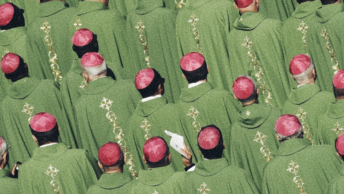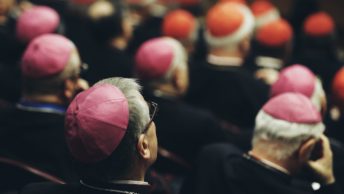The story of Catholic priests and sex abuse is back in the news and it is no less painful for Catholics this time than it was the last. Some may be thinking, “There’s no point in visiting the same moral swamp again. There’s been too much revelation, too much scandal already. Better to be spared the disgusting details of a new one.” That attitude, though understandable, is mistaken. More understanding is needed and deeper meaning grasped, not just by the laity, but also and more importantly by the hierarchy.
The latest abuse report was filed in August, 2018 by a Pennsylvania Grand Jury on its investigation of Catholic priests in six dioceses in the state. Using the Church’s own records, the Grand Jury concluded that for over 70 years 300 priests abused 1,000 children in six of the state’s eight dioceses, adding that “ the real number—of children whose records were lost, or who were afraid ever to come forward—is in the thousands.” Moreover, the teen and pre-teen victims “were brushed aside . . . by church leaders who preferred to protect the abusers and their institution above all” by not reporting the abuse and, instead, transferring the abusers to other parishes where they typically victimized other children.
An earlier report, the 2004 John-Jay Report, claimed that there had been a total of “10,667 reported victims (younger than 18 years) of clergy sexual abuse in the U.S. between 1950 and 2002.” Similar scandals have occurred in other countries on other continents. And then as now the hierarchy, including Popes John Paul II, Benedict XVI, and Francis have condemned them. In his response to the Pennsylvania report, Cardinal Daniel DiNardo, president of the US Conference of Catholic Bishops, expressed shame and sorrow over the new abuses, adding that “we already know that one root cause is the failure of episcopal leadership.”
Cardinal DiNardo’s description of the “root cause” is unfortunate. It makes it seem like a minor mistake such as having ambiguous procedures or insufficient pep talks for diocesan priests, when in fact the hierarchy’s “failure” fits the legal definition of aiding and abetting criminal activities after the fact. In other words it constitutes a crime! Here are some of the specific behaviors the Grand Jury reported:
“Priests were raping little boys and girls, and the men of God who were responsible for them not only did nothing; they hid it all. For decades . . . In the Diocese of Erie, despite a priest’s admission to raping at least a dozen young boys, the bishop wrote to thank him for “all that you have done for God’s people . . . The Lord, who sees in private, will reward . . . “
“Special agents testified” that the following practices “regularly appeared” in the diocesan files they had analyzed, practices that were “like a playbook for concealing the truth.” 1) “Use euphemisms rather than the real words to describe the sexual assaults.” 2) “Don’t conduct genuine investigations with properly trained personnel.” 3) “For an appearance of integrity, send priests for ‘evaluation’ at church-run psychiatric treatment centers.” 4) “When a priest does have to be removed, don’t say why. Tell his parishioners that he is on ‘sick leave,’ or suffering from ‘nervous exhaustion.’ 5) “Even if a priest is raping children, keep providing him housing and living expenses, although he may be using these resources to facilitate more sexual assaults.” 6) “If a predator’s conduct becomes known to the community, don’t remove him from the priesthood . . . Instead, transfer him to a new location where no one will know he is a child abuser.” 7) “Finally and above all, don’t tell the police.”
The sins of the abusing priests were despicable, to be sure. But the sins of the prelates were, in one important sense, worse. Moral theology leaves no doubt about this. Whereas the abusers acted out of compulsive passion (twisted and aberrant, to be sure), the prelates acted out of calm and carefully considered calculation, and that is more culpable. Jesus, of course, did not comment on the punishment of abuse-abetters or -enablers, but He did speak with frightening clarity about the punishment of abusers: “Whoever causes one of these little ones who believe in Me to stumble, it would be better for him to have a heavy millstone hung around his neck, and to be drowned in the depth of the sea.” (Matt 18:6)
Given the hierarchy’s handling of clerical sex abuse, it is clear that they must offer much more than vague references to “failure of episcopal leadership” if they are to have any hope of regaining the trust of Catholics and the respect of others. They should have no difficulty understanding this; after all, they have heard innumerable confessions and need no reminder that sins must be acknowledged before being forgiven.
To be more specific, prelates will need to demonstrate that they understand why their behavior was sinful, grasp the enormity of the harm they have caused, and discern what needs to be done to prevent its recurrence. Such a demonstration will necessarily answer the questions that trouble not only Catholics but all thoughtful people.
How could the prelates’ priorities have been so wrong?
After all, their signs of their office are a recurring reminder of their sacred commission: rings symbolizing their marriage to their dioceses and their people, and croziers (staffs) symbolizing their responsibility as shepherds to guide their “flocks” to salvation. According to St. Isidore, the crozier is given in expectation that the bishop will “govern and correct those below him or to offer support to the weakest of the weak.” [Emphasis added.]
Given that the role of caring for their their “flocks” is central to their office, there was no defensible reason for shielding those who did grave physical, intellectual, and spiritual harm to members of those flocks. Concern about possible scandal to the church, though a common excuse, is never a valid reason for abdicating their core responsibility.
Were the prelates intimidated by homosexuals in the clergy?
Given the sensitivity of the gay community about any association of homosexuality with the sexual abuse scandals in the Church, anyone approaching the subject is expected, at the very least, to acknowledge that being gay is not synonymous with sexually abusing others. That is a fair expectation, and I accept it. Yet that does not mean that the homosexual dimension of the scandals must be avoided; in fact, prudence requires that it be addressed. After all, according to the John-Jay Report, 81% of the abuse victims in the United States were male. (Another study says it could be as high as 90%.) It would defy logic to link that behavior to a heterosexual urge.
Fr. Andrew Greeley coined the term “Lavender Mafia” to describe “a group of homosexual dilettantes” who hijacked seminaries, screened out heterosexual candidates for the priesthood, and encouraged gay promiscuity among the others. Michael Rose detailed the dominance of these individuals and their impact on the training of priests in his 2002 book Goodbye, Good Men.
The seminary practice of rejecting heterosexuals and accepting homosexuals surely affected the numbers of each group over the decades. Nevertheless, the percentage of homosexual priests is difficult to pinpoint. Estimates range from 10% to 60%, compared to the overall average in society of 1.5%.
The number of homosexual bishops and cardinals is even more difficult to find in the research. Some speculate that it is about the same as the number of gay priests, which is plausible given that they went through the same seminary selection process as priests. (The numbers are supported by the high rate of priests who died of AIDS—roughly ten times the national average—and by a separate survey of 500 priests, 45% of whom volunteered that they were gay and one in four had AIDS.)
In light of these considerations, it is plausible to conclude that the prelates who defended and enabled the abusive priests did so because they a) were abusers themselves, b) were not abusers but were homosexuals and thus felt protective of the abusers, or c) were heterosexuals who had been conditioned by their seminary experience not to judge homosexual acts, even despicable ones.
Why were the bishops so lacking in empathy for the victims?
The laity was informed of the details of abuse only through investigative reporting and grand jury statements. But the bishops and cardinals knew the stories years, even decades, ago. Here are three from the current report:
A woman says the very word “God” still brings to mind images of the priest who assaulted her early childhood. Another woman was reportedly “raped by a priest at the age of seven in her hospital room after surgery on her tonsils, was raped again by the same priest at age 13, and then again at age 19 while pregnant [and] considered suicide.” An 83 year old man who was sexually abused by a priest says that for decades he “couldn’t show any affection” toward his wife and “couldn’t hold or hug” his children.
Such stories (incidentally, not among the most disgusting) bring the average person to tears. But prelates evidently felt no empathy for the victims. If they had, they would have done everything in their power to make sure the priests were not allowed to hurt others. So why didn’t they? Did being unmarried make it difficult for them to feel as deeply for others as spouses feel toward one another and their children? Were they afraid that public knowledge of evil in their dioceses would be viewed as a stain on them and an obstacle to advancement in the hierarchy? In the latter case, their concern would have been more about self than about the Church.
Make no mistake, in abandoning the young victims of sexual abuse in their time of need, the prelates, heirs of the Apostles, abandoned Christ Himself, who warned, “To the extent that you did it to one of these brothers of Mine, even the least of them, you did it to Me.’ (Matt 25: 31-46)
Why didn’t the prelates display at least worldly wisdom?
Prelates are charged with running large enterprises and whatever their other qualities may be, they are certainly expected to be good stewards of diocesan finances, and that entails, from a practical standpoint, limiting exposure to meritorious lawsuits. Yet for more than a half-century such stewardship did not occur.
According to the John Jay report, from 1950 to 2002 10,667 allegations of sexual abuse of a minor were brought against 4,392 priests. A timely, and simultaneously moral, response to the early allegations—dismissing the abusers from the priesthood rather than moving them clandestinely from parish to parish—would have not only minimized scandal and preserved the hierarchy’s integrity, but mitigated the financial cost of the abuse, as well.
The latter failure proved to be no small matter. According to Donald Cozzens in The Changing Face of the Priesthood, U.S. dioceses paid over 1800 claimants of abuse a total of $1.269 BILLION, which resulted in 13 dioceses filing for bankruptcy. (The money presumably came from the U.S. laity with neither their prior knowledge nor consent.)
How did the bishops and cardinals who abdicated their responsibilities by ignoring the victims and defending the perpetrators rise to the hierarchy of the Church?
This is not an unfair question, given that the bishops who abetted and enabled the abusive priests clearly had difficulty applying the principle of priorities, which is taught in Moral Theology 101. The qualifications for bishop specified in 1 Timothy 3 include being “above reproach . . . temperate, sensible, respectable, hospitable, an apt teacher . . . gentle, [and] not quarrelsome.” The office of cardinal, since the Council of Trent, has been reserved for “the most select persons only . . . [and] most eminently upright and competent shepherds.” [Emphasis added.]
In our time, the path to becoming a bishop, according to Father Peter Daly, involves these steps: 1) Become a personal secretary to a bishop, 2) “Get an advanced degree, preferably in canon law,” which he terms “the instruction book on the machinery of the church,”3) “Get a Roman connection” or one with the U.S. Conference of Catholic Bishops, and 4) know “which way the wind is blowing in Rome,” so as to adjust your sails.
If Daly sounds cynical, it is because he is, and with good reason. He points out that despite the large and growing need for parish priests, most bishops have very little parish experience—as he puts it, they lack the “smell of the sheep.” Accordingly, “they are more comfortable being CEOs than pastors.”
I would add that they are more comfortable with groupthink than with independent reflection and judgment. Having seen outspoken priests who were honest and zealous for the gospel being assigned as assistant pastors at St. Nowhere in the diocesan boondocks, they regard keeping a low profile as a key criterion for advancement.
It is clear, then, that the prelates were guilty not only of the grievous sin (and from a legal perspective, crime) of abetting and enabling sexual abusers, but also of grievously failing in their stewardship of Church finances. In short, the prelates failed abysmally in both of their major obligations! The gravity and duration of these failures explain why no amount of hierarchical lamenting and apologizing can be sufficient to gain the trust of God’s people. Saying is not enough; there must also be doing, for “Not everyone who says to Me, ‘Lord, Lord,’ will enter the kingdom of heaven, but he who does the will of My Father who is in heaven will enter.” (Matt 7:21)
The unanswered question remains, “What exactly should be done about the sexual abuse scandal?” The answer is whatever best addresses the root problem, which is not the detestable sins of the abuser-priests, but the indefensible responses of the bishops and cardinals to those sins. To be more specific, the answer is whatever will provide the Church with bishops and cardinals who:
Have the right priorities, notably putting the spiritual well-being of their flocks above all else, as Jesus commanded.
Resist intimidation and/or manipulation by any movement or group, within or outside the Church, whose agenda is at odds with the Gospel.
Understand the everyday challenges faced by the men, women, and children that comprise their flocks, and respond with words and actions that demonstrate the kindness, compassion, and empathy modeled by Jesus.
Take seriously the stewardship entrusted to them not only over God’s people, but also over the Church’s intellectual and spiritual heritage and its material possessions.
Strive to gain, and maintain, the personal qualities specified in 1 Timothy 3—being “above reproach . . . temperate, sensible, respectable, hospitable, an apt teacher . . . gentle, [and] not quarrelsome,” as well as those specified in the Council of Trent—being“eminently upright and competent shepherds.”
What action will provide the Church with such people? A simple change in the requirements for being elevated to the office of Bishop (and beyond that, to Cardinal). In place of the “requirements” explained above by Father Daley, there would be just these two:
The completion of at least five years of pastoral service in a Catholic parish.
The recommendation of one or more of the pastors under whom one served.
This change (which would of course come from Rome) is simple, but its impact would be monumental. By providing deep and meaningful involvement in the real world of the people of God before advancement to the hierarchy, it would form and strengthen in the candidate the Christian values needed to resist the counter-values common to hierarchic bureaucracy. No less important, this change would in time produce bishops and cardinals who would make both lay people and honorable priests proud rather than ashamed.
Copyright © by Vincent Ryan Ruggiero. All rights reserved









Great article – except: Prof. Ruggierios’ 2 requirements for elevation to the Episcopy are, at best, paltry. Five years of pastoral experience at one parish is meaningless without a record of measured excellence in pastoral performance, especially regarding spiritual growth.
A recommendation from a prior pastoral superior, while nice, is worthless in the current environment. Many pastors of parishes large enough to have a curate are themselves guilty of the negligence in leadership cited and have themselves been poorly formed in seminaries and lack the moral judgement necessary.
One qualification that would be useful would be for dioceses to measure the regular participation of children at Sunday Mass for each parish. Since most dioceses already keep close track of Mass attendance for the purpose of assessment, a minor tweak of the accounting would suffice. If when measured during the tenure of the each pastor there is a high and growing percentage and of this age group relative to overall attendance then the pastor in the diocese with the best record should be selected. He’s obviously excelled in his (spiritual) job.
???
Great article and hopefully many priests, bishops and cardinals will go to jail which may cause other homosexual and heterosexual abusers to repent and stop the abuse. The root problem is dominated by homosexual sexual deviants and of course their bosses who are the same homosexual predators. I say ban all homosexuals from the priesthood. The APA once rightfully called homosexual attraction a severe mental illness. It clearly is!